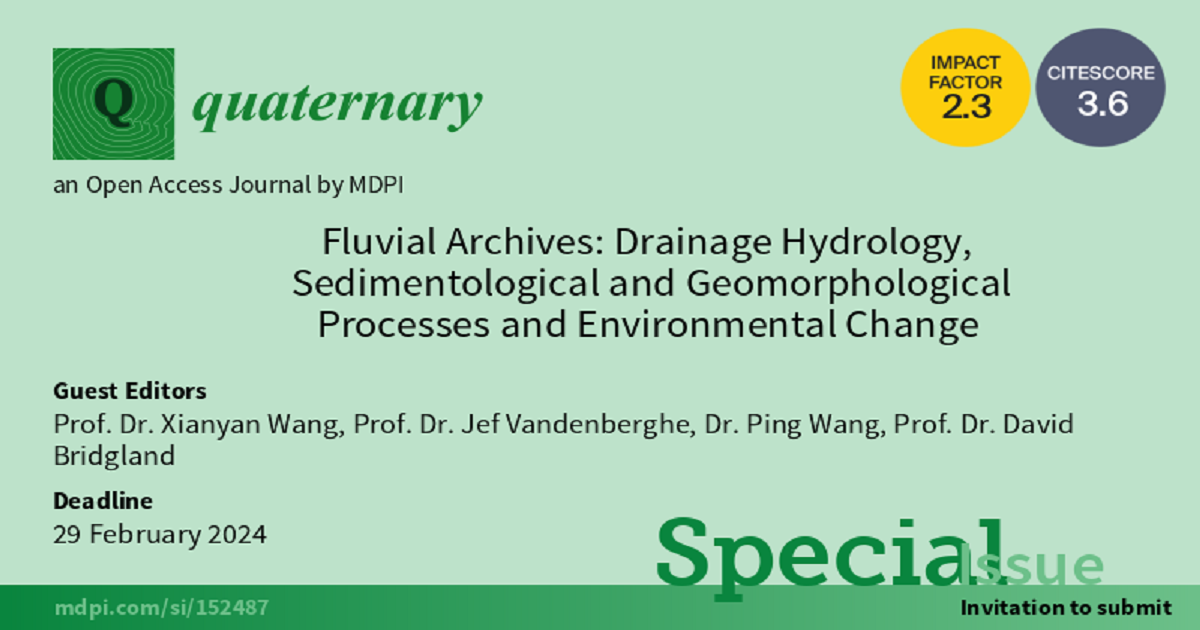- 2.1Impact Factor
- 4.1CiteScore
- 39 daysTime to First Decision
Fluvial Archives: Drainage Hydrology, Sedimentological and Geomorphological Processes and Environmental Change
Special Issue Information
Dear Colleagues,
Rivers in different settings are key components of landscapes and sediment systems, from uplands to offshore settings. The ubiquity of fluvial sedimentary records and the morphological expression of both sedimentary and erosional landforms provide important clues for exploring drainage hydrology, drainage and landscape evolution, and climatic–tectonic control over longer periods. In mountainous and lowland areas, fluvial archives are configured into staircase sequences and/or basin-filling sequences. They record tectonic and a tectonic uplift, climate-linked denudation and deposition and base-level related drainage-network changes. Climate-related river-terrace sedimentation provides insight into environmental changes, sediment supply sourcing and routing, and paleo-flood discharge at different timescales and in different climatic and geomorphological settings. In lowland areas, distributive fluvial systems develop thick sediment sequences, providing high resolution records of sedimentological and geomorphological processes.
This special issue will disseminate ongoing and recently developed fluvial research from palaeo to modern. This will include field investigations and modeling fluvial hydrology, sedimentology, geomorphology, neotectonics and paleohydrology from a range of tectonic and climatic settings.
Prof. Dr. Xianyan Wang
Prof. Dr. Jef Vandenberghe
Dr. Ping Wang
Prof. Dr. David Bridgland
Guest Editors
Manuscript Submission Information
Manuscripts should be submitted online at www.mdpi.com by registering and logging in to this website. Once you are registered, click here to go to the submission form. Manuscripts can be submitted until the deadline. All submissions that pass pre-check are peer-reviewed. Accepted papers will be published continuously in the journal (as soon as accepted) and will be listed together on the special issue website. Research articles, review articles as well as short communications are invited. For planned papers, a title and short abstract (about 250 words) can be sent to the Editorial Office for assessment.
Submitted manuscripts should not have been published previously, nor be under consideration for publication elsewhere (except conference proceedings papers). All manuscripts are thoroughly refereed through a single-blind peer-review process. A guide for authors and other relevant information for submission of manuscripts is available on the Instructions for Authors page. Quaternary is an international peer-reviewed open access quarterly journal published by MDPI.
Please visit the Instructions for Authors page before submitting a manuscript. The Article Processing Charge (APC) for publication in this open access journal is 1600 CHF (Swiss Francs). Submitted papers should be well formatted and use good English. Authors may use MDPI's English editing service prior to publication or during author revisions.

Benefits of Publishing in a Special Issue
- Ease of navigation: Grouping papers by topic helps scholars navigate broad scope journals more efficiently.
- Greater discoverability: Special Issues support the reach and impact of scientific research. Articles in Special Issues are more discoverable and cited more frequently.
- Expansion of research network: Special Issues facilitate connections among authors, fostering scientific collaborations.
- External promotion: Articles in Special Issues are often promoted through the journal's social media, increasing their visibility.
- e-Book format: Special Issues with more than 10 articles can be published as dedicated e-books, ensuring wide and rapid dissemination.

